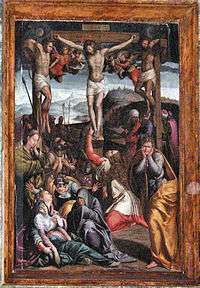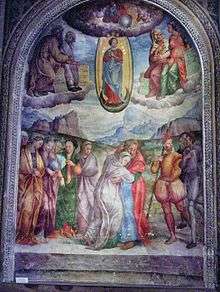Dono Doni
Dono Doni, also known as Adone Doni or Dono dei Doni (1505-1575) was an Italian painter of the Renaissance period active mainly in Umbria.


Biography
Doni was born at Assisi. While is said by Lanzi and others to have been a disciple of Pietro Perugino,[1] the first we know of him was that in 1530 he was an assistant to Giovanni di Pietro (lo Spagna) at San Giacomo in Spoleto.[2]
In the church of San Francesco, at Perugia, is a picture by this master of the 'Last Judgment;' and one of the 'Adoration of the Kings' is in San Pietro in the same city. There are in the Lower Church of the Franciscan Convent at Assisi frescoes by him representing the 'Preaching and Martyrdom of St. Stephen,' and in the small refectory is the 'Last Supper,' painted in 1573, which was probably his last work. Doni died at Assisi in 1575. Vasari is wrong in stating that he was a nephew of Taddeo Bartoli. In the Berlin Gallery there is by him a 'Madonna with the Infant Jesus,' who is represented as reaching after a book which is in the Virgin's hand.
He worked chiefly at Assisi. For the church of San Crispolto of Bettona, he painted an Adoration of the Shepherds (1543), now at the Pinacoteca Civica of the town. For the Ciccoli family chapel at the church of San Francesco in Bevagna, he painted a Madonna and Child (ca. 1565), now in the city picture gallery. In Foligno, he painted a fresco depicting the Nativity with St Lucy (1544) for the monastery of Sant' Anna, a frieze for the Sala Papale of Palazzo Trinci (attributed, ca. 1545), a fresco depicting the Martyrdom of St Catherine of Alexandria for the nunnery of Santa Caterina Vecchia, now detached and in the Pinacoteca Civica. In Gubbio, he painted a Pietà (after 1560) and a Road to Calvary (ca. 1564) now in the Duomo.[3] He also worked with Lattanzio Pagani and Cristofano Gherardi at the no longer-extant Rocca Paolina of Perugia.
References
| Wikimedia Commons has media related to Dono Doni. |
- The History of Painting in Italy: The schools of Rome and Naples (1828), By Luigi Lanzi, page 40
- Key to Umbria biography.
- Key to Umbria biography.
Attribution:
